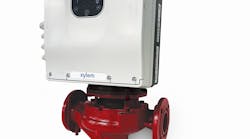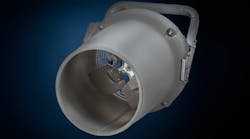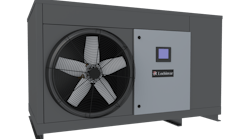Proper installation of all components in dehumidification systems is essential to achieving design conditions. This article addresses installation issues associated with cooling and desiccant-dehumidification equipment and systems.
COOLING-COIL APPLICATIONS
There are a multitude of factors concerning the installation of cooling coils for dehumidification applications. These considerations are common to all types of fluid (chilled water, glycol/water mixtures, engineered fluids, refrigerants).
Air velocity
The first issue we address with cooling-coil applications is air velocity. Once system airflow and coil-performance requirements are established, velocity is used to generate the actual size of a coil. A maximum velocity is applied to cooling coils to minimize the potential for carryover from the coils. Carryover occurs when the condensate on a coil is affected by the airflow and carried past the drain pan for the coil, instead of staying in contact and draining directly away from the unit. Although the risk varies based on the actual conditions, an airflow velocity limit of 500 fpm is typical industry practice. Where higher velocities are used, moisture eliminators are provided downstream of the coil to extract any carryover entrained in the conditioned-air stream.
Drain pan
The drain pan associated with a coil must be oriented to drain condensate away from a coil as quickly as the condensate is generated via the dehumidification process. The pans must be sloped toward the drain to prevent any accumulation of stagnant water, thereby avoiding the potential for mold to develop. The pans are insulated so that the cold water collected does not cause condensation on the exterior of the pan.
Drain trap
The drain pan must be provided with a trap. The depth of the trap depends on the pressure rating for the fan and whether the coil is in a blow-through or draw-through configuration. Care must be taken to make sure the required depth of the trap can be accommodated without modifications to the roof or floor slab adjacent to the coil.
Maintenance considerations
Each coil should have an access panel upstream and downstream of its installation to facilitate inspection and cleaning. Adequate service access must be provided outside the coil housing so that it can be removed and replaced in the event of a coil failure. Service and control valves for the coil must also be installed where they can be accessed without obstructing access doors or coil-pull space.
LIQUID-DESICCANT APPLICATIONS
Liquid-desiccant systems work on the principal of chemical absorption of water vapor from air. They are comprised of a conditioner section, which introduces the liquid-desiccant solution into the air stream to be dehumidified, and a regeneration section, where the absorbed water is evaporated out of the desiccant solution into a “scavenger” exhaust-air stream. The desiccant solution is transferred between the two sections via interconnected piping. Heat exchangers are provided for cooling the solution delivered to the conditioner and for heating the solution sprayed into the regenerator, along with pumps for circulating the desiccant solution. Fans also are required for drawing air to be dehumidified through the conditioner and regeneration sections to facilitate removal of moisture from the desiccant solution. The air-discharge sections of the conditioner and regenerator are furnished with mist eliminators to prevent carryover of moisture into the air streams leaving the equipment.
Conditioner and regenerator
The conditioner and regenerator can be installed indoors or outdoors, but if installed outdoors, the equipment must be properly freeze-protected, including any water, steam, and steam-condensate piping associated with the system coolers and heaters. The conditioner section should be insulated to prevent surface condensation on the equipment because liquid-desiccant solution sprayed into the air stream to be dehumidified can be cooled to a temperature below the ambient-air dew point. The equipment must be installed level and should be surrounded by curbing to contain any spills in the event of an accidental release of solution.
Ductwork
Ductwork connected to the equipment must be designed to provide uniform air distribution across the inlet to ensure proper performance of the dehumidification and regeneration processes. A diffuser screen may be required at the equipment duct connections to ensure good inlet conditions.
Because the regenerator exhaust-air stream is hot and moisture-laden, the exhaust-air ductwork typically is constructed from fiber-reinforced polyester (FRP), featuring water-tight joint construction with long horizontal runs pitched in the direction of airflow and low-point condensate-collection drains.
Piping
Desiccant-solution piping also typically is constructed from socket-welded FRP because the solutions (usually lithium chloride salts) are incompatible with metal-piping materials.
Maintenance access
Access doors should be provided in all inlet and discharge plenums to facilitate servicing of mist eliminators and diffuser plates.
Adequate space must be provided around the conditioner, regenerator, and heat exchangers to allow access for maintenance and equipment removal. This includes making sure that piping installed to serve the equipment maintains the necessary access clearances.
SOLID-DESICCANT APPLICATIONS
Solid-desiccant systems are similar to liquid-desiccant ones in that they have a conditioner and a regeneration section.
Solid-desiccant dehumidification systems feature a rotating wheel constructed of solid-desiccant materials, such as silica gel. The wheel rotates, first exposing the wheel to the air stream to be dehumidified, at which point the desiccant material absorbs moisture and then turns the wheel to expose it to a “reactivation air stream,” where moisture held in the desiccant material is extracted by passing heated air through the wheel.
Reactivation-air stream
Because the reactivation air must be heated to “dry” the wheel, and the air coming out of the regeneration process must be exhausted as it is hot and moisture-laden, the unit should be located close to an outdoor air inlet and a suitable building-exhaust point. The inlet air is filtered. The exhaust air discharged from the unit must be located so that it does not adversely impact any building air intakes. The exhaust ductwork serving the reactivation section must be capable of handling high-temperature, moisture-laden air.
Heat source
The heat for the regeneration air can be provided by an electric or steam coil or direct-fired gas heater.
Post-cooling
A post-cooling coil is required in the air stream to be dehumidified, downstream of the wheel, to remove any excess heat added to the air stream from the reactivation process.
CONCLUSION
The key to success in applying dehumidification systems is to address the installation issues associated with each system. When designing dehumidification systems, it is important to focus on the detailed installation requirements of the equipment and components chosen for the application.
For previous Equipment Notebook articles, visit www.hpac.com.
As Kling's director of mechanical services, Charles A. Rowland, PE, LEED AP, is responsible for all aspects of the design of HVAC, process, plumbing, and other mechanical systems. As an engineering design principal, Martin J. Wendel Jr., PE, is responsible for engineering leadership and supervision of all mechanical-services disciplines, including HVAC, process plumbing, fire protection, and instrumentation and controls.








